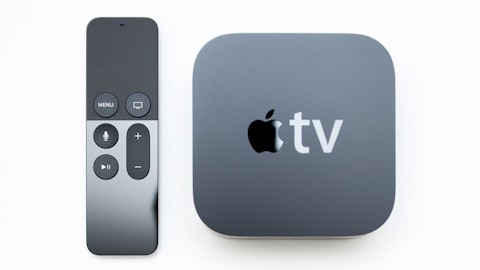Roku, Inc. (NASDAQ:ROKU) Q3 2023 Earnings Call Transcript November 1, 2023
Roku, Inc. misses on earnings expectations. Reported EPS is $-2.33 EPS, expectations were $-1.99.
Operator: Good day, and thank you for standing by. Welcome to the Roku Third Quarter 2023 Earnings Conference Call. At this time, all participants are in a listen-only mode. After the presentation, there will be a question-and-answer session. [Operator Instructions] Please be advised that today’s conference is being recorded. I would now like to hand the conference over to your host today, Conrad Grodd, Vice President of Investor Relations. Please go ahead.
Conrad Grodd: Thank you, operator. Good afternoon, and welcome to Roku’s third quarter 2023 earnings call. I’m joined today by Anthony Wood, Roku’s Founder and CEO; and Dan Jedda, our CFO. Also on today’s call for Q&A are Charlie Collier, President, Roku Media; and Mustafa Ozgen, President, Devices. Full details of our results and additional management commentary are available in our Shareholder Letter, which can be found on our Investor Relations website at roku.com/investor. Our comments and responses to your questions on this call reflect management’s views as of today only, and we disclaim any obligation to update this information. On this call, we’ll make forward-looking statements, which are predictions, projections, or other statements about future events, such as our financial outlook, our commitment to positive adjusted EBITDA for full year 2024, and continued improvements thereafter, our investments, future market conditions, and macro environment uncertainties.

Concept Photo/Shutterstock.com
These statements are based on our current expectations, forecasts, and assumptions, and involve risks and uncertainties. Please refer to our Shareholder Letter and periodic SEC filings for risk factors that could cause our actual results to differ materially from these forward-looking statements. We’ll also discuss certain non-GAAP financial measures on today’s call. Reconciliations to the most comparable GAAP financial measures are provided in our Shareholder Letter. Finally, unless otherwise stated, all comparisons on this call will be against the results of the comparable period of 2022. Now, I’d like to hand the call over to Anthony.
Anthony Wood: Thanks, Conrad. We are executing well as the shift to TV streaming continues and delivered a strong quarter. We grew our scale with net adds of 2.3 million active accounts, an acceleration from the previous quarter. We drove strong engagement with streaming hours surpassing 100 billion for the first time on a trailing 12-month basis. And The Roku Channel remains the top 10 streaming app with engagement comparable to Paramount Plus, Peacock, and Max, according to Nielsen. On the monetization side, Platform revenue was up 18% year-over-year, reflecting strong contribution from content distribution and video advertising. We continued to tap into new ad demand sources and are now integrated with more than 30 programmatic partners.
Spend on the Roku platform through automated third-party demand sources in Q3 grew meaningfully year-over-year. And we expanded our partnerships with marquee brands this quarter. With Spotify, we introduced video ads in the Spotify app on Roku devices, and with the NFL, we launched the first league-branded zone in the Roku Sports Experience. We continued to make progress in reducing our year-over-year OpEx growth rate. In September, we announced additional measures that included a reduction of our workforce and office facilities and the removal of select content. These measures and other cost reductions, along with our strong top-line growth, enabled us to deliver adjusted EBITDA of $43 million in Q3. Going forward, we will balance investment for growth with our commitment to positive adjusted EBITDA for the full year 2024.
And we expect continued adjusted EBITDA improvements after that. With our growing scale and engagement, relentless focus on providing the best TV streaming experience and ongoing innovation, we are well positioned as the ad market recovers. Now, I’ll turn it over to Dan to discuss our results.
Dan Jedda: Thanks, Anthony. We ended the quarter with 75.8 million active accounts globally, up 16% year-over-year. Sequential net adds of 2.3 million accelerated quarter-over-quarter. Overall, Smart TV unit sales in the US were up year-over-year in Q3, driven by a consumer focused on value that benefited Roku, which grew significantly faster than the overall industry. Roku player unit sales remained above pre-COVID levels, and the average Roku player selling price was up 2% year-over-year. Roku users streamed 26.7 billion hours in the quarter, an increase of 22% year-over-year while viewing hours on traditional pay TV fell 15%. Streaming hours per active account per day of 3.9 was up 5% year-over-year. In Q3, total net revenue increased 20% year-over-year to $912 million.
Platform revenue was up 18% year-over-year to $787 million, driven by both content distribution and video advertising, offset by lower media and entertainment promotional spend. Content distribution activities grew faster than overall Platform revenue, benefiting from increased subscription signups, along with recent price increases from SVOD partners. Similar to Q2 2023, Platform revenue and gross profit also benefited from a positive 606 adjustment from changes in forecasts of our content distribution deals. Q3 Devices revenue increased 33% year-over-year, driven by the launch of our Roku-branded TVs and Smart Home products. In Q3, ARPU was approximately $41 on a trailing 12-month basis, down 7% year-over-year, but up quarter-over-quarter for the first time since Q3 of last year.
We expect ARPU to benefit in future periods from a recovery in the ad industry. In Q3, gross profit was $369 million, up 3% year-over-year. Excluding restructuring and impairment charges, gross profit was up 22% year-over-year. Platform gross margin was 48%, down 5 points sequentially, driven primarily by a $62 million impairment charge related to the removal of select license and produced content from The Roku Channel. Excluding the impairment charge, Platform gross margin would have been 56%, a 3 point increase sequentially. Devices margin was negative 8%, which was up nearly 10 points sequentially. Q3 adjusted EBITDA was positive $43 million. The better-than-expected performance was driven by strong top-line growth along with cost reductions and measures we announced in September to further reduce our year-over-year OpEx growth rate.
Free cash flow for Q3 was positive $239 million, and we ended the quarter with over $2 billion in cash and restricted cash. Looking to the fourth quarter, we anticipate total net revenue of $955 million, up 10% year-over-year; gross profit of $405 million, with gross margin of 42%; and positive adjusted EBITDA of $10 million. Within the Platform segment, we had a solid rebound in video ads in Q3, and we expect year-over-year growth rate of video ads in Q4 to be similar. However, we remain cautious amid an uncertain macro environment and an uneven ad market recovery. Ad verticals like CPG and health and wellness continue to improve, while verticals like financial services and M&E remain challenged. Additionally, we will face difficult year-over-year growth rate comparisons in content distribution and M&E, which will challenge the year-over-year growth rate of platform revenue in Q4.
Within Devices segment, we expect Devices margins to be down sequentially, in line with historical seasonal trends, but up year-over-year. We anticipate both the sequential point decrease and the year-over-year point increase to be in the low teens. As a reminder, Q4 is traditionally a heavier promotional period in the retail calendar, resulting in lower Devices margins in the quarter relative to other quarters. Turning to OpEx, we anticipate Q4 year-over-year growth in the negative mid-teens, a significant improvement from OpEx year-over-year growth of approximately 70% in Q4 of last year. We will continue to operate our business with discipline to defend margins with a focus on driving positive free cash flow over time. Additionally, we remain committed to achieving positive adjusted EBITDA for full year 2024 with continued improvements after that.
We will balance this commitment with investments to further expand our scale, engagement, and monetization. With that, let’s take questions. Operator?
See also 12 Most Expensive Cigars in the World in 2023 and 30 Most Popular Wine Brands in America.
Q&A Session
Follow Roku Inc (NASDAQ:ROKU)
Follow Roku Inc (NASDAQ:ROKU)
Operator: [Operator Instructions] Our first question will come from the line of Cory Carpenter with JPMorgan.
Cory Carpenter: Hey, thanks for the question. I’m hoping you could go a bit deeper just into the different trends you’re seeing across M&E upfront in the scatter markets. Charlie, maybe specifically for you, anything that you would call out on impact from geopolitical events in 4Q? And then, Dan, maybe if you could just tie it all together into how those kind of various cross-currents got you to your 4Q guide? Thank you.
Anthony Wood: Hey, Cory, thanks. This is Anthony. So, yeah, Charlie will take that first part of that question and Dan the second part.
Charlie Collier: Okay. Thanks, Anthony. And hey, Cory, I hope you’re well. I’ll start in second quarter. We saw a continued rebound in video advertising from second quarter into third quarter. And in third quarter, year-on-year growth of video advertising on Roku actually outperformed the overall ad market and the linear ad market in the US. So, while we’re optimistic about the ongoing rebound in video advertising on our platform, we remain cautious about the uncertain macro environment and the uneven ad market recovery by category. Actually, Cory, for instance, CPG and health and wellness are growing and doing quite well, but there’re still categories like financial services and insurance that are not recovering as quickly.
And you mentioned M&E. I expect M&E to be further pressured in fourth quarter by, of course, the limited fall release schedules because of labor strikes. And there are some challenging comps. Last year, if you remember, included the world cup and a healthy seasonal and full theatrical schedule and more. So, I’d say sort of trend wise, we had a solid, really solid rebound in video ads in third quarter. And though there are the ups and downs I mentioned, we’re executing well, and I fully expect the year-on-year growth rate of video ads in fourth quarter to be similar to third. Dan, you want to…
Dan Jedda: Yeah. Hi, Cory. Thanks for the question. Let me just tie that what Charlie just said into how it impacts the Q4 guide. Yes, we did have a very solid video ads rebound in Q3. We do expect, as Charlie said, the year-over-year growth rate in video ads to be similar in Q4. And he also said that we remain cautious and uncertain for the macro environment, the uneven ad market recovery. I do want to add that we also do face a difficult year-over-year growth rate comparison in content distribution and M&E. And that does challenge the sequential growth rate change from Q3 to Q4. We had a very strong Q3 in our content distribution activities. That comp gets harder in Q4 and that’s factored into our guide. And so, from a sequential basis, when you look at Q4 2023, growing slower than Q3 2023, some of this harder comp and some of it is timing.
If you look at our H2 compared to H1 of this year relative to our H2 compared to H1 of last year, you’ll see a 9 point sequential change in the second half of 2023 relative to 2022. So, that’s also playing into the guide. And I understand by saying we expect to demonstrate further leverage in our business while our outlook — with an outlook that calls for double-digit increase year-on-year in gross profit and a double-digit decrease year-over-year in OpEx, and that’s what’s driving the positive adjusted EBITDA for Q4.
Anthony Wood: Hey, Cory, this is Anthony again.
Cory Carpenter: Thank you.
Anthony Wood: I’ll just — if I could just wrap it up, I’ll just add that I feel good about our commitment to achieving positive adjusted EBITDA for the full year 2024. And obviously with continued improvements after that, I also feel good about continuing to invest in our business while also meeting those targets. So, things are looking good for us right now.
Cory Carpenter: Thank you. Thanks.
Operator: Our next question comes from a line of Michael Nathanson with MoffettNathanson.
Michael Nathanson: Thanks. Hey, Charlie, I have two for you. One is, as you noted in the press release, Roku Channel is up 50% year-over-year. Could you talk a bit about what’s changed on your watch in terms of how you program it versus previously? And then, secondly, we’re all focused on Amazon entering the market for Prime Video Ads. What do you think it means for, more broadly, the ecosystem? And then, any competition that you think you’ll hit as they enter for Prime Video advertising? Thanks.
Anthony Wood: Hey, Michael, this is Anthony. Let me start with the question about video ads and competitors, and then Charlie can expand on the rest of your question. So, just — I would say, first of all, we’re the leading TV streaming platform. It’s a great position to be in. We get asked about market dynamics a lot. We founded Roku on the belief that all TV, including advertising, is going to be streamed and we’re, obviously, seeing that happen. We’re well into that transition, but there’s still a long way to go. Traditional TV ads in the US, as everyone probably knows, is a $60 billion a year business. It’s all going to move to streaming and there’s going to be multiple winners. Our platform, obviously, has significant scale, engagement, first-party data, unique ad products.
And like we said before, in the US, our scale is approaching half of broadband households, that makes us a tremendously important platform to be involved in for everyone in the ecosystem. Our streaming hours passed 100 billion hours, great milestone for us. The Roku Channel, as Charlie will talk more about, it’s a top 10 streaming app on our platform and represents nearly 3% of all TV streaming in September, not just on Roku, but across everywhere, which is comparable to the engagement of apps like Paramount Plus, Peacock, and Max. So, we’re in a great position. We’re a strong part of the ecosystem. We’re executing well. And if I think about a couple of factors that would be impacting the growth of our video ad business specifically, the most important one, which we’ve mentioned before and continues to be the most important, is just the macro — well, one is the macro environment, which is impacting everyone right now.
And then — but the second one is just how fast advertisers move from traditional TV to streaming. There’s still a lot of dollars that are in the traditional pay TV ecosystem that are all going to move to streaming. And that’s a big factor in terms of our growth. And I think as services like — services that were traditionally ad-free start to add ads, it does have the benefit of creating more interest in advertisers and moving their ads to streaming. So that’s a positive benefit for us. And then, I think another thought I have, maybe most people don’t think about, is if you think about The Roku Channel, as popular streaming services make the trade-off to add ads, it levels the playing field in viewers’ minds with services like The Roku Channel, which are already ad-supported.
In other words, in streaming services that don’t traditionally have ads as they enter the advertising business, I believe it’s going to increase engagement on The Roku Channel. So, those are a few high-level thoughts. And then, Charlie, you want to add your thoughts?




